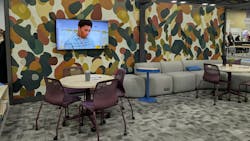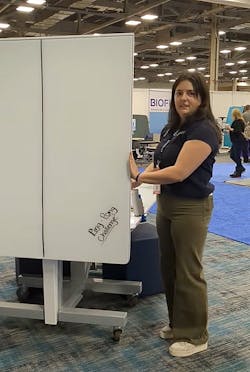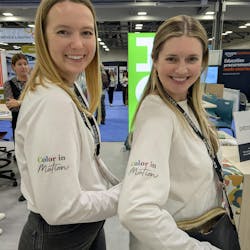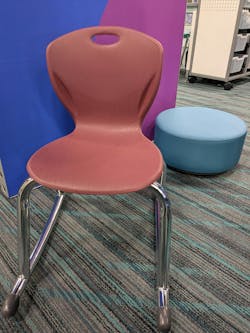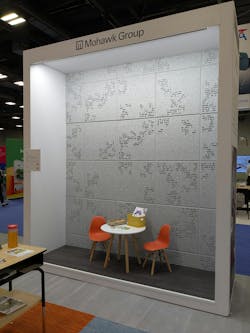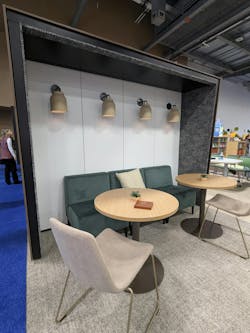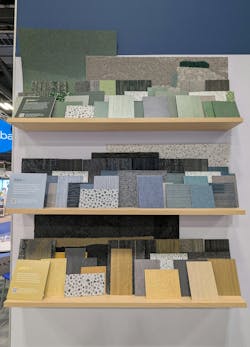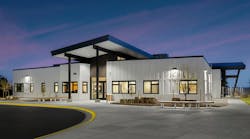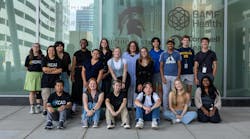How Education-Market Strategy Shapes Classroom Design
-
Student input reveals what fuels collaboration and curiosity, guiding more authentic, real-world learning spaces.
-
New color research helps designers energize learning environments without overstimulating students or staff.
-
Inclusive design fosters belonging by adapting to diverse sensory and physical needs within one cohesive classroom.
-
Wellness, flexibility, and sustainability now define performance-driven education spaces that nurture focus, comfort, and connection.
Last week, my first visit to EdSpaces (Nov. 5–7; Columbus, Ohio) felt less like walking a trade show and more like stepping into a conversation about what it means to empower learners and educators. Each discussion and display revealed how thoughtful design can strengthen well-being, belonging, and purpose—shaping classrooms into cultures of learning. I left envisioning education environments as living ecosystems that both demand and provide care, adaptability, and connection by design. Supporting them means designing for people first, nurturing students and staff to thrive within spaces built for growth. Here’s how exhibiting manufacturers plan to assist.
1. Survey the Student User
“Getting [students] out of their technology silo and giving them a space and tools to problem solve together—it’s great practice for the real world.”
Senior marketing specialist Anna Hayes, Ghent, shared key points she has learned in volunteering with a high-school-level marketing class. She finds ways to incorporate student feedback and preferences—like their desire for hands-on learning opportunities—into Ghent product discussions, while also helping teens to understand product positioning and intent.
2. Color A New Perspective
“[We] realized we were doing color all wrong.”
Nicole Funk, Central region marketing manager, and Meredith O’Brien, social media & content creation marketing manager, championed the new “Color in Motion” slogan for HON. With more recent findings in color theory and behavior, “we realized we were doing color all wrong” for learning environments, Funk explained.
Moving on from a color-blocking application of vibrant primary hues, HON developed a softer palette with energizing tones ranging from mellow yellow golds and leafy greens to muted burgundy, terracotta, and plum that don’t overstimulate. A bonus is that the desaturated palette is also designed to appeal in staff amenity spaces (see top of page), said senior product portfolio manager Marcus Simpao (not shown).
3. Differentiate, But Design for Belonging
“Design classes around students rather than around the building. Learn how they interact and what helps them to be successful.”
Artcobell marketing director Alison DeMartino shared an anecdote about outreach from a physical therapist seeking a seating option that would support a special-needs student’s vestibular motion—but didn’t make them feel “separated out” from their peers in the classroom or cause a distraction. The Discover Rocker allows students the motion they need to focus and participate, while presenting a cohesive style with other classroom seating. This embodies the idea that classroom design can help all kids feel a sense of belonging, while respecting and accommodating their differences.
4. Personas Help Stretch the Range of Adaptable Designs
“The ‘f’ word of our industry is ‘flexibility’—we have to provide solutions that can adapt to all learners and especially help administrators to maximize space, functionality, and budget.”
In a former life, KI’s VP of Education Bryan Ballegeer worked in educational operations management, so he understands how to help administrators balance budget without sacrificing the flexibility that we now know learners need. Through market research, KI has identified what it calls “Eight Performance Design Considerations” that directly influence student success. Ballegeer told me that these design performance standards empower educators to realize an active and adaptable ecosystem for learning environments. They include:
- Accessibility
- Environmental comfort
- Ergonomics and movement
- Multisensory modulation
- Physical safety and security
- Emotional safety and belonging
- Community and connection
- Sustainability and stewardship
The upshot: Agile, modular products designed to comfortably accommodate a range of sensory needs, body types, sitting positions, and learning modes contribute to academic and interpersonal success in schools. You can learn more about the performance framework in a blog on KI’s website.
5. Apply Research Advances for Lower-Stress Environments
“It’s more important now than ever to design environments that create a sense of belonging and help to reduce stress.”
Mohawk Group continues to seek ways to apply the fractal pattern research developed by 13&9 and Dr. Richard Taylor. According to brand strategy director Tracy Cook, the rising mental health crisis—particularly among young people—has made it clear that designs across all verticals can influence well-being. And manufacturers are listening for opportunities to develop education products backed by evidence-based design studies. Mohawk added more soft and hard flooring pattern/color options to its fractal collections, and incorporated coordinating acoustic panels from FACT Design into its exhibit to demonstrate a more holistic approach to grounding occupants in education spaces.
6. Prioritize Personnel Needs, Too
“We understand work, and we’re focused on well-being. It’s a good match for the higher-ed and teaching staff spaces.”
Multiple EdSpaces exhibitors and speakers emphasized the importance of designing products and spaces to serve education professionals and empower them to manage their well-being. In one of the designed classrooms, partners from Steelcase Learning, Orangebox, and HKS held an informal lunchtime discussion to highlight some of their well-being findings and engage in conversation with attendees about staff needs for psychological safety, community, and focused zones.
During my 1:1 visit in the Steelcase brands’ “neighborhood,” Bryan Campbell, Kelly Cramton, and Kathy Waterman agreed the Orangebox “Campers & Dens” offer a customizable, multipurpose way to incorporate interior architecture zones that provide space for respite, privacy, consultation, and individual tasks without requiring a large footprint. (Exterior alcove shows that it’s not only the enclosure that matters, but also the various amenities that can expand their use.)
7. Simplify Sustainability for Healthier Schools
“We think about what’s in the product.”
At every level of the education field, observed Patcraft director of education Paula Meason, facilities/operations managers and decision makers tend to focus on how long products stay in the building. And longevity is a valid step toward sustainability. But as part of the company’s Inside-Out philosophy, “we think about what’s in the product,” Meason said, “and both [durability and materials awareness] need to come together.”
Guided by materials heath, circularity, climate impact, and social fairness standards, Patcraft aims to eliminate perceived trade-offs between performance and sustainability. Utilizing Red List Free recycled materials, providing a coating for older asbestos-containing floors before new product install, and streamlining flooring and surface maintenance needs all contribute to a healthier school environment—and their bottom line.
Education Extra Credit
About the Author
Carrie Meadows
Editor-in-Chief
Carrie Meadows is Editor-in-Chief of interiors+sources (i+s), where she leads editorial strategy, content development, and brand storytelling focused on the people, projects, and innovations shaping the design industry. With more than two decades of experience in B2B media, she has built a career connecting technical expertise with creative insight—translating complex topics into meaningful stories for professional audiences. Before joining i+s in 2024, Carrie served as Editor-in-Chief of LEDs Magazine within Endeavor Business Media’s Digital Infrastructure & Lighting Group, guiding coverage of emerging lighting technologies, sustainability, and human-centric design. Her earlier editorial experience spans across Laser Focus World, Vision Systems Design, Lightwave, and CleanRooms, where she managed print and digital publications serving the optics, photonics, and semiconductor sectors.
An advocate for clear communication and thoughtful storytelling, Carrie combines her editorial management, SEO, and content strategy expertise to help brands and readers stay informed in a rapidly evolving media landscape. When she’s not crafting content, Carrie can be found volunteering at a local animal shelter, diving into a good crime novel, or spending time outdoors with family, friends, and her favorite four-legged friends.
